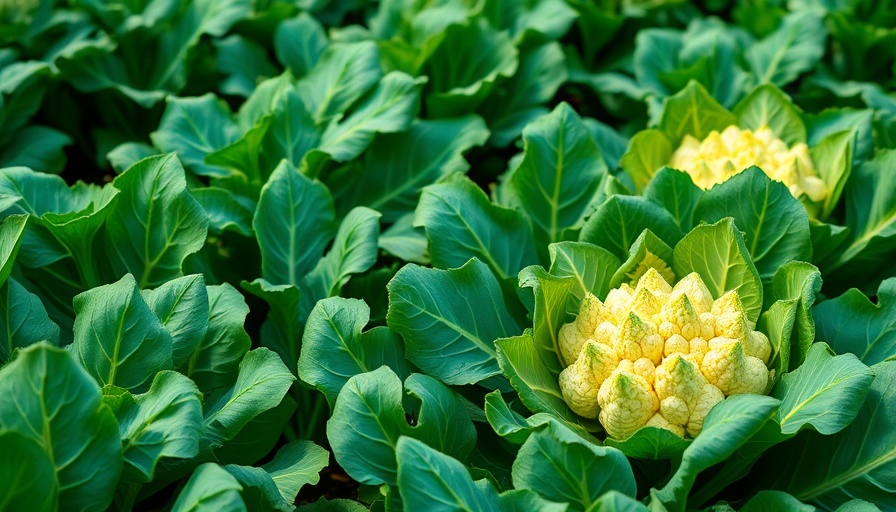
Recognizing Common Cauliflower Pests
Cauliflower, a beloved member of the brassica family, faces numerous pest threats that can devastate both its appearance and health. Urban and suburban gardeners, whether beginners or seasoned enthusiasts, must educate themselves on these pests to safeguard their investments in hard work and resources. Understanding these common culprits can lead to practical solutions and better yields.
A Comprehensive Guide to Nine Common Cauliflower Pests
Here’s a closer look at the nine common pests that can plague your cauliflower plants, complete with recognition tips and management strategies.
1. Aphids
Aphids are small, sap-sucking insects that can quickly spread diseases like the cauliflower mosaic virus. Identifying them might be tricky due to their size; however, their yellowish patches on leaves serve as clear indicators. If you encounter an aphid infestation, start by rinsing them off with a firm stream of water. For more serious infestations, consider using organic neem oil, a dual-purpose insecticide that is both eco-friendly and effective.
2. Cabbage Loopers
These green caterpillars with a distinctive inchworm-like movement are notorious for decimating crops. Look for their tiny yellow eggs on leaves. Combat these pests with organic Bacillus thuringiensis (Bt), allowing you to control the population without harming beneficial insects.
3. Cabbage Moths
Cabbage moths are insidious due to their capability of laying eggs in plain sight. Their larvae, like cabbage loopers, are voracious eaters. Implementing physical barriers, such as floating row covers, can serve as a preventative measure to keep these pests at bay.
4. Cabbage White Butterflies
These butterflies are often seen fluttering around gardens. Yet, their eggs transform into caterpillars that munch through your plants' leaves. Hand-picking these can be fruitful, or you can use organic deterrents.
5. Cabbage Whiteflies
Similar to aphids, cabbage whiteflies are also sap-suckers that can cause harm. Their presence results in a white, powdery look underneath the leaves. Yellow sticky traps are an effective way to monitor and eventually manage their numbers.
6. Cross-Striped Cabbage Worms
Keep a lookout for these green worms with white stripes, as they can quickly consume your plants. One natural solution is introducing beneficial insects like parasitic wasps that naturally prey on their larvae.
7. Flea Beetles
These tiny black jumping beetles create holes in leaves that may seem insignificant but can lead to larger issues. Opt for protective row covers to prevent flea beetles from accessing your plants, especially during early growth stages.
8. Slugs and Snails
These slimy critters are particularly problematic for tender leafy vegetables like cauliflower. Strategies like setting beer traps or creating barriers with crushed eggshells can be effective in controlling their populations.
9. Cabbage Root Maggots
These pests can attack the roots of young plants, choking their growth. A robust companion planting strategy is often effective; consider incorporating specific plants that deter these pests.
Creating a Pest-Resistant Cauliflower Garden
Implementing preventative measures is essential in reducing pest problems. This can include practicing crop rotation, ensuring good soil health, and using pest-resistant cauliflower varieties. Home gardeners should also consider integrating companion planting techniques, which can naturally deter pests while promoting healthy growth. For example, planting garlic or marigolds among cabbages can provide potent defenses against many common pests.
Embracing the Beauty of Imperfection
Every gardener faces challenges, including pests. Understanding that some damage is sometimes part of the journey can cultivate resilience. Join local gardening groups or online forums for shared advice on pest management and organic gardening solutions. Gardening is not just about vegetables; it's about growing community connections and personal satisfaction.
Engaging with Nature through Gardening
Developing a relationship with your food as it flourishes can be a fulfilling process. Recognizing pests and understanding their cycles allows gardeners not just to protect their crops but also to engage deeply with nature's rhythms. As you embark on your gardening journey, remember that patience and persistence are key. Everyone can learn to cultivate healthy, delicious produce—one pest at a time.
Ready to dive deeper into the magical world of gardening? Explore our resources for organic gardening techniques, and take the first step toward growing your own vegetable garden today!
 Add Row
Add Row  Add
Add 




 Add Row
Add Row  Add
Add 

Write A Comment